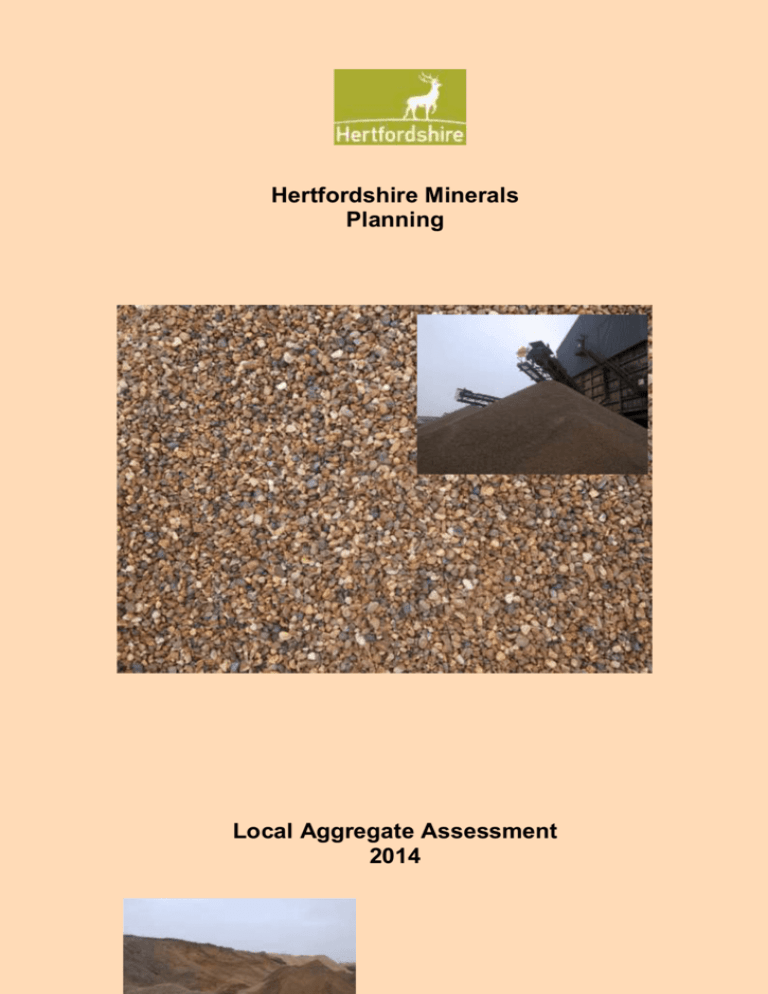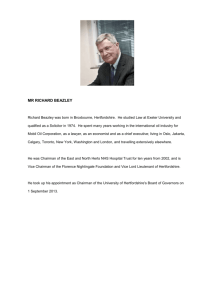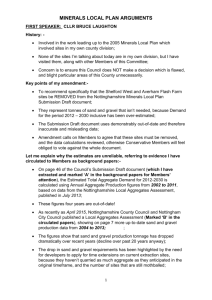
Hertfordshire Minerals
Planning
Local Aggregate Assessment
2014
Local Aggregate Assessment (November 2014)
1
CONTENTS
1. Introduction
2. Geology of Hertfordshire
Sand and Gravel
Chalk
Clay
Hard rock
Marine aggregates
3. Sand and Gravel Sales
Extraction sites
Apportionments
Local approach to determining apportionment figures
Landbank of permitted mineral reserves
Timeline for mineral planning
Imports and exports
Sales and consumption
Rail aggregate depots
Brick Clay
Chalk
4. Recycled and Secondary Aggregate
5. Future aggregate supply and demand
Supply
Demand
6. Conclusion
3
3
4
5
6
6
6
6
8
10
11
12
13
14
17
17
19
20
20
24
24
25
27
LIST OF TABLES
Table 1:
Table 2:
Table 3:
Table 4:
Table 5:
Table 6:
Table 7:
Sand and gravel sales compared with permitted reserves in
Hertfordshire since 2007
Permitted sand and gravel extraction in Hertfordshire with reserves
Landbanks for sand and gravel in Hertfordshire in 2011
Hertfordshire’s primary aggregates imports and exports (2009)
Sales and consumption in 2009
Permitted chalk extraction sites in Hertfordshire
Provision of sand and gravel in Hertfordshire to 2027
LIST OF FIGURES
Figure 1:
Figure 2:
Figure 3:
Figure 4:
Figure 5:
Figure 6:
2
Geological map of the main mineral resources of Hertfordshire
Sales of sand and gravel in Hertfordshire 2003-2012
Geology of Hertfordshire with permitted sand and gravel sites
Comparison of Hertfordshire’s total sand and gravel sales 20032012 and apportionment levels
Hertfordshire’s rail aggregate depots
Location of permitted sites in Hertfordshire for the production of
recycled/secondary aggregates
Local Aggregate Assessment (November 2013)
1.
INTRODUCTION
1.1
The Government recognises the importance of minerals to support
sustainable economic growth and our quality of life. They are a finite
resource and can only be worked where they are found. The National
Planning Policy Framework (NPPF) (March 2012) paragraph 145 requires
Minerals Planning Authorities to monitor aggregate production and plan for a
steady and adequate supply of aggregates.
1.2
This document has been prepared to fulfil the requirement introduced within
the NPPF to produce an annual Local Aggregate Assessment (LAA). It has
been prepared in line with guidance within the National Planning Policy
Guidance (NPPG).
1.3
The purpose of the LAA is to assess the current local mineral provision
against the requirements detailed in the NPPF and NPPG, including the
Government’s Guidance on Managed Aggregate Supply System which has
now been incorporated into the NPPG. The document details performance
in line with the East of England Aggregates Working Party. It also reviews
guidance from the government’s Department for Communities and Local
Government relating to the NPPF. The county council will update this
document on an annual basis and will use its contents to inform the review of
Hertfordshire’s Minerals Local Plan.
1.5
This LAA details the current supply and demand in Hertfordshire, from which
information relating to existing sites, reserves and aggregate apportionment
levels to 2031 (plan period for the new Minerals Local Plan), based on the
agreed East of England apportionment figure and rolling average of ten
years sales data and other relevant local information, is included within this
document. Other potential sources of aggregates are included, namely
recycled and secondary aggregates, imports and exports.
2.
GEOLOGY OF HERTFORDSHIRE
2.1
The main mineral resources in Hertfordshire are sand and gravel with smaller
deposits of chalk and brick clay (as shown in Figure 1).
2.2
The geology of Hertfordshire is largely Chalk of the Cretaceous period,
overlain in the south and east by London Clay. In the far north and northwest
of the county are small areas of Gault Clay. Throughout much of the county,
the superficial deposits which overlay the solid geology complicate the
picture. These include the Clay-with-flints of much of west Hertfordshire;
including the Chilterns dip slope; the boulder clay of central and east
Hertfordshire; and the gravels of the Vale of St Albans and the river valleys.1
2.3
Sand, gravel, crushed rock, chalk and clay all provide the construction
industry with the raw materials required for constructing and maintaining
roads, buildings and other infrastructure. Minerals are also essential
elements in the production of a variety of other products. An adequate and
steady supply of minerals is essential if current standards of living are to be
1
Biodiversity Action Plan for Hertfordshire 2006, www.hef.org.uk
Local Aggregate Assessment (November 2014)
3
maintained in society as well as meeting basic needs for quality of life, such
as shelter.
Figure 1: Geological map of the main mineral resources of Hertfordshire
2
© Crown copyright and database rights 2014 Ordnance Survey 100019606
Reproduced with the permission of the British Geological Survey ©NERC. All rights
Reserved
Sand and Gravel
2.4
Sand and gravel resources occur in Hertfordshire within superficial or ‘drift’
deposits, subdivided into fluvioglacial sand and gravel, glacial sand and
gravel, river terrace deposits and sub-alluvial deposits.3
2.5
Sand and gravel deposits are found in most parts of the county although they
are concentrated in an area south of a line between Bishops Stortford in the
east and Hemel Hempstead in the west (often referred to as the sand and
gravel belt). This area covers the whole of the District Council areas of Three
Rivers, Watford, Hertsmere, Welwyn Hatfield and Broxbourne. Large parts of
the City and District of St Albans and East Hertfordshire are covered,
BGS & ODPM, 2003, Technical report CR/03/075/N Mineral Resource Information in support of National, Regional and
Local Planning: Hertfordshire and Northwest London Boroughs
3 BGS & ODPM, 2003, Technical report CR/03/075/N Mineral Resource Information in support of National, Regional and
Local Planning: Hertfordshire and Northwest London Boroughs
2
4
Local Aggregate Assessment (November 2013)
together with a small part of Dacorum. North Hertfordshire and Stevenage
Districts fall outside the sand and gravel belt.
2.6
Of the sub-alluvial gravel deposits, these occur within the valleys of the rivers
Mimram, Ver and Colne of St Albans and Hemel Hempstead areas.
Resources have in many cases been extensively worked and exhausted in
the Ver and Colne valleys.
2.7
Sand and gravel from Hertfordshire is mostly used by the construction
industry. Most is washed and screened to remove clay particles and to
separate the various sized stones and larger stones are usually crushed and
screened again. Most sand extracted in Hertfordshire is sharp sand and is
suitable for making concrete (when mixed with various selections of gravel
sizes, cement and water).
2.8
Crushed rock (imported to Hertfordshire) may be used in place of local
gravel, but sand may only be substituted by fines from crushed rock which is
more costly to use because of its lesser binding properties. Building sand, for
use in mortars, may also be washed and screened before use. Known as
soft sand it is less commonly found in the county and is mostly imported.
2.9
Currently sand and gravel extraction takes place at four quarries in
Hertfordshire;
o
Panshanger Quarry, Hertford;
o
Tyttenhanger Quarry, Colney Heath;
o
Westmill Quarry, Ware;
o
Hatfield Quarry with the linked Symondshyde extraction site.
In addition, Rickneys Quarry just north of Hertford has temporary permission
for extraction, however it is yet to be implemented.
Two other sites have extant planning permission for sand and gravel
extraction, although no extraction is now taking place, these are Water Hall
and Dobbs Weir Quarries (see Table 2 for further details).
Chalk
2.10
Chalk occurs as bedrock throughout much of the county. It is a major aquifer
and is the most important source of groundwater in the county. The White
Chalk runs through Watford and Hertford although much is covered by
superficial deposits and chalk crops out along the sides of the valleys of the
rivers Ash and Lea near Hertford and the Colne valley. The Grey Chalk is
found in the north and far west of the county.
2.11
The Chilterns area within Hertfordshire is an area that consists of rolling chalk
hills capped with Clay-with-Flints superficial deposits. This area runs from
Tring to Hitchin, through Welwyn, St Albans and Watford. Steep chalk scarp
slopes are found in Tring with gentler slopes covering a larger area. Gentler
chalk hills than the Chilterns are found in the East Anglian Chalk area which
runs from the Chilterns through Hertfordshire and South Cambridgeshire.
2.12
There were many chalk extraction sites in the past, essentially for local use.
However today, the scale of working is relatively small and chalk is mainly
Local Aggregate Assessment (November 2014)
5
quarried at a small number of sites to the north and west of the sand and
gravel belt. Chalk in Hertfordshire is extracted for use as an agricultural lime
on farms both within and outside the county.
2.13
There are currently three chalk extraction sites in Hertfordshire:
o
Codicote;
o
Bedwell Park just outside of Hertford; and
o
Anstey.
Clay
2.14
Hertfordshire sits within the Northern Thames Basin Character Area with
geology of mostly London Clay overlain with superficial deposits of sand and
gravel. The west Anglian Plain with geology of Gault Clay adjoins the
northern part of the county and the Eastern Anglian Plain covers a large part
of the East of the county with underlying chalk with a covering of Boulder
Clay.
2.15
The scale of working for brick clay is relatively small. The only brick clay is
located in the Hemel Hempstead area. Brick clay is extracted for use at
specialist brickworks in the county, of which there is one remaining in the
county, in Bovingdon. The bricks are made from mottled clays of Reading
Formation and Clay-with-Flints.
Hard rock
2.16
There is no hard rock found in the county. Hertfordshire imports crushed rock
into the county via the rail aggregate depots. Reserves from outside of
Hertfordshire will be relied upon for this source of mineral.
Marine aggregates
2.17
3.
Hertfordshire is a land locked county and as such contains no areas suitable
for the dredging of marine aggregates. A relatively small amount of marine
sand and gravel is consumed in the county which is imported via Kent and
London.
SAND AND GRAVEL SALES
3.1
Sales of sand and gravel (including soft sands) for the ten year period
between 2004 and 2013 inclusive are shown in Figure 2. The figures are
based on actual sales data retrieved from the county’s Aggregate Monitoring
Survey.
3.2
However, there have historically been difficulties in obtaining mineral data and
this problem is recognised nationally. Only some minerals data is made
available to the minerals planning authority or can be inaccurate, inconsistent
and incomplete. The county council is part of the East of England Aggregates
Working Party (EEAWP), which is a technical working group comprising
mineral planning authorities and other interested parties that are working
together to obtain better survey data which is used by individual authorities
and collated in the East of England Authorities’ Monitoring Report. It is hoped
6
Local Aggregate Assessment (November 2013)
that in the years to come the data available for both minerals and waste will
be more available and consistent.
Figure 2: Sales of sand and gravel in Hertfordshire 2004 – 2013
0.99
1.27
1.12
1.13
20 13
1.01
1.17
20 12
0.97
1.21
20 10
1.05
20 08
1.2
1.0
1.23
20 07
Million tonnes
1.4
20 09
Total Sand and Gravel Sales
0.8
0.6
0.4
0.2
20 11
20 06
20 05
20 04
0.0
Year
Source: HCC AMR 2013 and EEAWP Aggregate Monitoring Survey return 2013
3.3
Sand and gravel production in 2013 was very similar to that in 2012. Sales
peaked twice over 1.20 million tonnes over the last 10 year period.
3.4
The average sales of sand and gravel in Hertfordshire over the last 10
years is 1.12 million tonnes (2004-2013). As a comparison, this figure was
1.13 million tonnes as of 2012, 1.17 million tonnes as of 2011 and 1.21 million
tonnes in 2010, showing a downward trend.
3.5
The rolling 3 year average is 1.17 million tonnes per annum (2011-2013).
This highlights a downward trend from the 1.19 million tonnes per annum in
2012 and 1.22 million tonnes per annum recorded for the end of 2011.
3.6
Based on 2013 levels Hertfordshire contributed 12% of the sand and gravel
sales in the East of England region4.
3.7
Of the sales of primary aggregates in Hertfordshire in 2009, 74% was within
Hertfordshire (890,000 tonnes), 3% was to the East of England (39,000
tonnes) and 23% was to other destinations (278,000 tonnes).5
3.8
Figures for reserves are available from 2007. The table below shows the
sales figure alongside the reserves figure for sand and gravel in Hertfordshire.
4
East of England Aggregates Working Party Annual Monitoring Report 2013
9d, DCLG & BGS, 2009, Collation of the results of the 2009 aggregate minerals survey for England and Wales
5 Table
Local Aggregate Assessment (November 2014)
7
Table 1: Sand and gravel sales compared with permitted reserves in Hertfordshire since
2001
Year
Sales of soft sand Permitted reserves of
and sharp sands soft sand and sharp
and gravel (tonnes)
sands
and
gravel
(tonnes)
2004
1,047,000
-
2005
965,238
-
2006
1,230,885
-
2007
1,010,466
10,840,668
2008
988,517
10,869,000
2009
1,214,3066
10,619,000
2010
1,172,890
10,786,465
2011
1,268,465
16,700,000
2012
1,123,645
15,792,000
2013
1,130,295
16,260,000
Source: HCC Annual Monitoring Report 2013 & Annual East of England Aggregates Working
Party Aggregates Monitoring Survey forms 2013
3.9
The table above shows that between 2007 and 2010 the permitted reserves of
sand and gravel in the county remained fairly constant; however this is now at
a higher level due to additional planning permissions and reassessment of
actual reserves by operators.
Extraction sites
3.10
There are currently seven quarries in Hertfordshire with planning permission
for the extraction of sand and gravel, with only four currently extracting. The
details of these are presented in Table 2 below.
3.11
Based on 2013 levels Hertfordshire contains 11% of the permitted sand and
gravel reserves in the East of England region7.
3.12
Anecdotal evidence suggests that sites are not producing enough sand and
gravel to keep up with demand.
6 There
is a slight difference between the figure in the HCC Annual Monitoring Report 2010 and the figure recorded by the
East of England Aggregate Monitoring Survey for 2009 (1,214,306t and 1,207,000t respectively)
7 East of England Aggregate Working Party Annual Monitoring Report 2013
8
Local Aggregate Assessment (November 2013)
Table 2: Permitted sand and gravel extraction sites in Hertfordshire
Active Site
Operator
Status
Westmill Quarry –
Ware
Hatfield Quarry –
Symondshyde Farm
Cemex UK Ltd
Active. Sand and gravel quarry with landfill
(local authority collected waste).
Active. Sand and gravel processing plant on
original Hatfield Quarry site area.
Tyttenhanger Quarry
– Colney Heath
Lafarge Tarmac
Panshanger Quarry –
Hertford
Lafarge Tarmac
Permitted but
Inactive Site
Operator
Rickneys Quarry –
Chapmore End
Water Hall
Hanson Quarry
Products Europe
Ltd
Frank Lyons
Dobbs Weir Quarry
Lafarge Tarmac
3.12
Cemex UK Ltd
Active. Sand & gravel quarry and inert landfill.
Permission in February 2011, for the extraction
on land identified as Preferred Area No.3, in
the Minerals Local Plan Review 2002-2016.
Restoration with inert fill in early dug areas.
Sand and gravel processing plant operational
on site.
Status
Mothballed site. No current extraction taking
place. Sand & gravel quarry and inert landfill.
Mothballed site. No current extraction taking
place. Sand and gravel reserves under plant
site which has a materials recovery facility
permitted until 31-11-2014.
No reserves remaining.
Cessation date for
planning
permission
31-12-2017.
01-10-2020.
31-12-2032.
Extraction to cease
by 31-12-2030.
Cessation date for
planning
permission
Unimplemented
permission.
Extraction to cease
in 2017.
Extraction and
processing to cease
in 2016. Restoration
until 2042.
In addition there are 4 sand and gravel quarry sites that are currently in the
restoration phase. These sites are as follows:
Pole
Hole/Hollingson Meads in Gilston near Harlow (inert landfill
permission expires 21-2-2042),
Great
Westwood Quarry near Watford,
Water
Hall in Bayfordbury near Hertford (Bunker’s Hill - inert landfill
permission expires 31-11-2014.
Hoddesdon
Quarry.
Local Aggregate Assessment (November 2014)
9
Figure 3: Geology of Hertfordshire with permitted sand and gravel sites
© Crown copyright and database rights 2014 Ordnance Survey 100019606
Apportionments
3.13
The current annual apportionment for Hertfordshire is 1.39 million tonnes of
sand and gravel.
3.14
The county’s sand and gravel apportionment figure has changed over time
due to periodic reviews. In 1998 the annual apportionment was set at 2.4
million tonnes. The annual apportionment in the current adopted Minerals
Local Plan was set at 1.99 million tonnes for the time period 2002-2016 (as
detailed in former Minerals Planning Guidance Note 6: Guidelines for
Aggregates Provision in England, 1994-2016, dated April 1994, as amended
June 2003). This figure was subsequently reviewed through the National
and Regional guidelines in 2009 and now stands at 1.39 million tonnes for
the time period 2005-2020. This sub-regional apportionment was approved
by the East of England Aggregate Working Party based on the Managed
Aggregate Supply System (MASS) which was in operation at the time and
now forms part of the NPPG.
3.15
Figure 3 provides a comparison of Hertfordshire’s sales figures over the ten
year period 2004 to 2013 against the county’s apportionments during this
period.
10
Local Aggregate Assessment (November 2013)
Figure 4: Comparison of Hertfordshire’s total sand and gravel sales 2004 - 2013 and
apportionment levels of 1.99 million tonnes in 2004 to 1.39 million tonnes from 2005
onwards
Sand and Gravel sales compared with
apportionments
Million tonnes
2.5
2
Apportionments
1.5
Sand and Gravel
sales
1
0.5
20 13
20 12
20 11
20 10
20 09
20 08
20 07
20 06
20 05
20 04
0
Year
3.16
The apportionment level changed in 2005 8 from 1.99mtpa to 1.39mtpa. It
can be seen in the graph that sales have been below apportionment levels
and do not meet apportionments for any year, although came close in 2006
and 2011.
3.17
The government has revised the apportionment over time. It announced
revised requirements for national and regional aggregates provision in 2009,
which were lower than the previous requirements published in 2003. When
regional planning was in place, the review of the East of England Regional
Plan recommended an annual apportionment of 1.44 million tonnes.
However, publication in September 2009 of the National and Local
Guidelines for Aggregate Provision in England from 2005-2020 9 provided a
figure of 1.39 million tonnes and with the abolition of regional planning this
apportionment figure has been agreed and set locally for Hertfordshire by the
East of England Aggregates Working Party.
3.18
The 2009 guidelines states in Annex A that the revised apportionment
reflects an overall fall in national demand for sand and gravel and crushed
rock, an increase in the assumed contribution use of alternatives to primary
aggregates notably construction and demolition waste, an increase in the
assumed contribution of marine sand and gravel and decrease in the
assumed contribution of net imports.
3.19
Figure 4 illustrates how this lower apportionment level reduces the gap
between sales and apportionments.
Local approach to determining apportionment figures
10 year and 3 year sales averages
3.18
The NPPF states in paragraph 145 that Mineral Planning Authorities (MPAs)
should prepare an annual LAA ‘based on a rolling average of 10 years sales
8 As
9
set out in CLG, 2009, National and regional guidelines for aggregates provision in England 2005-2020;
DCLG, 2009, National and regional guidelines for aggregates provision in England 2005-2020;
Local Aggregate Assessment (November 2014)
11
data, and other relevant information, and an assessment of all supply options
(including marine dredged, secondary and recycled sources)’. When
planning for a steady and adequate supply of aggregates, such local
information includes geology, environmental issues, local demand and past
patterns of supply.
3.19
The government’s aim is to provide a simpler and more transparent
approach to calculating the apportionment than the sub-regional
apportionment method that relies on a complex model incorporating a range
of confidential variables.
3.20
The NPPG suggests the use of the 3 year sales average to identify a general
trend in sales and consider increasing supply if this is appropriate. The
NPPG suggests that the rolling 10 year average , 3 year average sales and
sub-regional guidelines should all be had regard to in order to establish a
broad view of planned provision.
3.21
The difference in the agreed apportionment and average sales are as
follows:
Sales and apportionment
Million tonnes per annum
Agreed apportionment
1.39
10 year sales average
1.12 (2004-2013)
3 year sales average
1.17 (2011-2013)
3.22
The NPPG states MPAs can plan for more or less than the figure set out in
the sub-regional guidelines based on their LAA and ‘in those areas where
apportionment of the land-won element has already taken place, those
figures may be used as an indicator as to how much should be planned for’
(NPPG, paragraph 071).
3.23
There may be advantages of taking into account average sales data over a
period of time which levels out the peaks and troughs of an economic cycle
by accounting for periods of slow (2008-2011) and high (2001-2007)
economic growth. However, the table above shows that if the current ten or
three year sales averages were used to calculate the sand and gravel
landbank for Hertfordshire, this would result in a lower provision being
planned for. This figure will change yearly due to the rolling average of sales
data, but at present would place additional pressure on neighbouring MPAs
to meet any shortfall if the demand for aggregates rises such as increased
certainty of a higher level of future growth in the county as Local Planning
Authorities set their housing figures.
Landbank of permitted mineral reserves
3.24
Permitted reserves of sand and gravel in Hertfordshire (i.e. sites with
planning permission to extract) are currently 16,260,000 tonnes (as of the
end of 2013) (see table 1). The annual apportionment for Hertfordshire is
1,390,000 million tonnes based on the DCLG 2009 guidance.
3.25
By using the permitted reserves and dividing this figure by the annual
apportionment figure, this shows the landbank in years. A landbank is
12
Local Aggregate Assessment (November 2013)
defined in the Minerals Local Plan as ‘a stock of planning permissions for the
winning and working of minerals’.
3.26
The current landbank (as of the end of 2013) for Hertfordshire is 11.7 years.
3.27
As a comparison, landbanks for the previous years (all based on 1.39mtpa
since 2005) were as follows:
o 12 years in 2011 when additional planning permissions were
approved;
o 7.8 years in 2010. The reason for this lower figure is due to the fact
that Rickneys was not permitted at this time which is reflected in the
subsequent years.
3.28
Sand and gravel permitted reserves that make up the figure to calculate the
landbank are contained in six sites in Table 2 (Westmill, Hatfield,
Tyttenhanger, Panshanger, Rickneys and Water Hall). The latest return for
Dobbs Weir stated that there are no remaining reserves to extract.
3.29
Table 3 shows the most up-to-date landbank calculations based on the
reserves and showing the difference when sales figures are used compared
with the apportionment figure.
Table 3: Landbanks for sand and gravel in Hertfordshire in 2013
Permitted reserves as at 31/12/2013
East of England AWP apportionment for Herts 2005-2020
Landbank based on EEAWP apportionment (years)
16,260,000
1,390,000
11.7
Permitted reserves as at 31/12/2013
10 year average sales 2004-2013
Landbank based on 10 year average sales (years)
16,260,000
1,115,171
14.6
Permitted reserves as at 31/12/2013
3 year average sales 2011-2013
Landbank based on 3 year average sales (years)
16,260,000
1,174,135
13.8
3.30
The NPPF states that MPAs should make provision for the maintenance of
landbanks of at least seven years for sand and gravel and should prepare an
LAA based on a rolling average of 10 years sales data and other relevant
information. This is provided by way of securing planning permissions for
sites that will provide aggregate over this period to fulfil the apportionment on
a yearly basis. As stated in the table above, the landbank in the county is
currently above the recommended seven year level, when based on the
agreed EEAWP apportionment. The level of provision of sand and gravel
would be extended by further years when calculating it against the ten and
three year sales averages.
Timeline for mineral planning
3.31
For mineral planning purposes the landbank is crucial. The council will
consider the existing high level of planned provision when reviewing the
Minerals Local Plan. Based on the reserves and given the end date of the
existing Minerals Local Plan (2002-2016) and time for working up the review
Local Aggregate Assessment (November 2014)
13
document from now, it is considered that a reasonable time frame would be
2016-2031. This is in line with the NPPF, in paragraph 157 which states that
Local Plans should be drawn up over an appropriate time scale, preferably a
15-year time horizon.
Start of plan
2016
end of plan
2018
(11.7-14.6 year landbank) 2028-2031
2031
adoption
4.
IMPORTS AND EXPORTS
3.32
Data relating to the sales and consumption of aggregates are collected and
collated at the national and regional level. The most up to date published
figures have been used in this report.
3.33
A national four-yearly Aggregate Minerals Survey (AMS) provides in–depth
and up to date information of regional and national sales, inter–regional
flows, transportation, consumption and permitted reserves of primary
aggregates in England and Wales. Conducted by DCLG and BGS the latest
survey was carried out in 2009. Table 4 has been compiled using the AMS
2009 report with additional information obtained through direct
correspondence with the BGS relating to the origin and destination of
aggregates. For comparison purposes data from 2009 has been used, as
this is the year which has a complete set of data.
Table 4: Hertfordshire’s primary aggregates imports and exports (2009)
Mineral
Import
amount
(tonnes)10
Consumption Export
(tonnes)11
(tonnes)12
Land won sand
and gravel
Marine sand and
gravel
Total sand and
gravel
163,000
1,053,000
317,000
Balance
(importsexports)
(tonnes)
- 154,000
1,000
0
+ 1,000
164,000
1,054,000
317,000
- 153,000
Crushed rock
Total aggregates
413,000
577,000
413,000
1,467,000
0
317,000
+ 413,000
+ 260,000
1,000
Note: In balance column, a ‘-‘ prefix indicates a net export, and a ‘+’ prefix indicates a net import.
3.34
The latest Aggregate Minerals Survey in 2009 showed that movements of
sand and gravel into and out of Hertfordshire are not self-balancing (Table
4). Overall, Hertfordshire is a net exporter of sand and gravel, although there
10 Table
10, DCLG & BGS, 2009, Collation of the results of the 2009 aggregate minerals survey for England and Wales
11, DCLG & BGS, 2009, Collation of the results of the 2009 aggregate minerals survey for England and Wales
12 Table 9d (calculation of land won sand and gravel to the East of England plus elsewhere) DCLG & BGS, 2009,
Collation of the results of the 2009 aggregate minerals survey for England and Wales
11 Table
14
Local Aggregate Assessment (November 2013)
is a small amount of marine sand and gravel imported. Hertfordshire relies on
imports of crushed rock, as this is not found in the county.
Sand and Gravel
3.35
Of the total sand and gravel consumed in Hertfordshire (1,054,000 tonnes)
as reported in the AMS 2009:
85% came from within Hertfordshire;
5-10% came from Essex;
5-10% came from Bedfordshire (Central and Bedford Borough)
Milton Keynes, Cambridgeshire, Buckinghamshire, Kent, Derbyshire,
Staffordshire, Leicestershire and Northamptonshire each supplied less
than 1%;
(NOTE: Oxfordshire, Gloucestershire, Hampshire, Suffolk, Cheshire East
and Berkshire also supplied less than 1% each and tonnages were small
as to be only a few lorry loads).
Marine sources
3.36
Of the 1,000 tonnes of marine sand and gravel consumed in Hertfordshire
as reported in the AMS 2009 (Table 11):
3.37
49% was supplied via Kent;
51% was supplied via London.13
In summary, of the imports of sand and gravel into Hertfordshire, 94% came
from within the East of England area and 6% from outside the East of
England area. 14
Crushed Rock
3.38
Of the total crushed rock consumed in Hertfordshire (413,000 tonnes) as
reported in the AMS 2009 (Table 11):
3.39
58% came from Leicestershire;
20-25% came from Derbyshire;
5-10% came from Somerset;
5-10% came from Yorkshire Dales NP;
1-5% came from Powys;
Northamptonshire, Rutland, Cumbria and Oxfordshire each supplied less
than 1%. 15
In summary, of the imports of crushed rock, 100% came from outside the
East of England area. 16
Information supplied directly by BGS
Information supplied directly by BGS
15 Information supplied directly by BGS
16 Information supplied directly by BGS
13
14
Local Aggregate Assessment (November 2014)
15
From a national perspective the UK Minerals Yearbook 2013
following:
17
reports the
In the UK in 2012, there were;
3.40
50 million tonnes of sand and gravel consumed; and
83 million tonnes of crushed rock consumed;
526 sand and gravel workings in the UK (as at April 2014) 18;
Of the aggregates produced in the UK in 2012:- 19
3.41
41.8 million tonnes was land-won sand and gravel;
14.2 million tonnes was marine dredged sand and gravel;
93.5 million tonnes was crushed rock; and
3 million tonnes was clay and shale and fireclay (for bricks).
Total imports of sand and gravel and crushed rock into the UK in 2012 were 39.2
million tonnes and total exports from the UK were 68.2 million tonnes. 20
The Annual Minerals Raised Inquiry (AMRI) 2012 reports the following:
In Hertfordshire, 12,000 tonnes of clay was extracted and sold
for the manufacture of bricks, pipes and tiles; 21
In Hertfordshire, 25,000 tonnes of chalk was extracted and sold
for agricultural uses. 22
From the East of England area perspective the Area’s Annual Monitoring
Report 2013 reports the following:
Hertfordshire contributed 12% of sand and gravel sales in the East of
England in 2013; 23
Only Cambridgeshire & Peterborough has a higher landbank of sand and
gravel than Hertfordshire in the East of England; 24
The East of England landbank (average over all authorities) stood at 9.8
years using the sub-regional apportionment figure derived from the
National and regional Guidelines 2005-2020.; 25
Page 22, BGS, 2014, United Kingdom Minerals Yearbook 2013, Minerals and Waste Programme Open Report
OR/14/036
18 Page 18 of BGS, 2014, United Kingdom Minerals Yearbook 2013, Minerals and Waste Programme Open Report
OR/14/036
17
19
(http://www.bgs.ac.uk/mineralsuk/statistics/downloads/MineralsProducedInTheUnitedKingdom.pdf )
Page 19 of BGS, 2014, United Kingdom Minerals Yearbook 2013, Minerals and Waste Programme Open Report
OR/14/036
21 Table 8, DCLG & ONS, 2014, Annual Mineral Raised Inquiry (AMRI) ‘Mineral extraction in Great Britain 2012’, Business
Monitor PA1007
22 Table 9, DCLG & ONS, 2014, Annual Mineral Raised Inquiry (AMRI) ‘Mineral extraction in Great Britain 2012’, Business
Monitor PA1007
23 Figure 2 of East of England Aggregates Working Party, Annual Monitoring Report 2013
24 Page 7,of East of England Aggregates Working Party, Annual Monitoring Report 2013
20
16
Local Aggregate Assessment (November 2013)
Cambridgeshire & Peterborough and Norfolk are the only authorities in the
East of England that extract rock and propose to maintain current
extraction rates;
Although likely to be under-representations, in 2013 the EEAWP area
imported over 1.4 million tonnes of aggregate (sand and gravel and
crushed rock) from outside the area by rail depots and wharfs. In
comparison exports of aggregates from the area by rail were over 264,000
tonnes. 26
Sales and consumption
3.42
The following table shows the comparison of sales and consumption in
Hertfordshire in 2009.
Table 5: Sales and consumption in 2009
Destination
Hertfordshire
East of England
Elsewhere
Total Sales of Land Won Sand &
Gravel (2009)
Consumption
Proportion
74%
3%
23%
Assumed Figure
890,000t
39,000t
278,000t
100%
1,207,000t
1,467,000t
Source: DCLG & BGS, 2009, Collation of the results of the 2009 Aggregate Minerals Survey for
England and Wales
3.43
The AMS indicated that most of Hertfordshire’s sand and gravel produced is
consumed in the county (74%). Of the exports, the majority of the sand and
gravel is used outside of the East of England region (23%).
Rail aggregate depots
3.44
Linked with the mineral industry is the need for rail aggregate depots within
the county. Hertfordshire has a total of five such sites which are at:
Hitchin;
Langley Sidings, Stevenage;
Rye House, Hoddesdon;
Harper Lane, Radlett; and
Orphanage Road, Watford.
3.45
These are shown on the proposals map in the Hertfordshire Minerals Local
Plan, 2007 and Minerals Consultation Areas Supplementary Planning
document, and are safeguarded facilities.
3.46
Crushed rock passes through Langley Sidings. Concrete batching is carried
out at Orphanage Road, ready mix at Langley Sidings and Harper Lane and
25
Page 7,of East of England Aggregates Working Party, Annual Monitoring Report 2013
9 & 10 of East of England Aggregates Working Party, Annual Monitoring Report 2013
26 Pages
Local Aggregate Assessment (November 2014)
17
asphalt plants at Langley Sidings and Harper Lane. The asphalt plant is no
longer operating at Rye House, instead the site only handles dry stone.
However Hitchin rail aggregate depot is not currently operating.
3.47
18
Further discussions are planned to be carried out with the rail aggregate
depots to obtain a comprehensive understanding of the destinations of
minerals to and from these sites.
Local Aggregate Assessment (November 2013)
Figure 5: Hertfordshire’s rail aggregate depots
© Crown copyright and database rights 2014 Ordnance Survey 100019606
Brick Clay
3.48
Hertfordshire has one site which excavates brick clay for the use on-site in
the production of specialist bricks. The current planning permission at the
site runs until 31 December 2025 for extraction.
3.49
There is no apportionment for clay provision; however the NPPF requires
that a stock of permitted reserves of at least 25 years for brick clay is
required. The adopted Minerals Local Plan did not require a landbank of
brick clay. The review of the Minerals Local Plan therefore needs to address
this issue. This will be planned for in the review of the Minerals Local Plan
and could be shown as a Mineral Safeguarded Area(s).
3.50
Reserves at the site are unpredictable due to the nature of the deposit. In
accordance with the current planning permission, there are reserves at the
site for another 11 years. It is therefore unlikely that at present reserves will
remain over the life of the proposed plan period.
3.51
However, information in the EIA Screening Opinion submitted by the
specialist brickworks 27 indicates that there could be potential for a further
18.7 years of clay extraction subject to planning permission. This could result
in 29.7 years worth of clay when combined with the extant planning
Chamley Associates, April 2014, Bovingdon Brickworks Limited, Pudds Cross Proposed Brick-Clay Extraction,
Preliminary Outline for an Environmental Impact Assessment (EIA) Screening Opinion
27
Local Aggregate Assessment (November 2014)
19
permission lifespan, which would be more than sufficient to cover the
required 25 years supply stated in the NPPF.
3.52
In the interim, the existing policies in the adopted Minerals Local Plan 20022016 can be relied upon by decision makers to determine any planning
applications that may come forward until the Minerals Local Plan is reviewed.
The NPPF is a material planning consideration and therefore would need to
be taken into account. Therefore reference to the NPPF may be necessary
should any issues relating to clay come forward before the review of the
Minerals Local Plan.
Chalk
3.53
Chalk is extracted in Hertfordshire for use as an agricultural lime on farms to
improve soil quality and is therefore classed as an industrial mineral rather
than an aggregate used in construction (e.g. for use in cement). As such it is
not necessary to plan for a separate landbank for this resource.
3.54
The Annual Minerals Raised Inquiry Survey 2012 states that there were
sales of 25 thousand tonnes of chalk in Hertfordshire for agricultural uses.28
For information purposes and the monitoring of sites the table below
provides further information on these sites with permitted reserves:-
Table 6: Permitted chalk extraction sites in Hertfordshire
Site
Codicote
Quarry
Bedwell
Park
Quarry
Anstey
Chalk
Quarry
4.
4.1
Operator
Codicote
Quarry Ltd
BP Mitchell
Haulage
Contractors
Ltd
Status
Currently active.
Extraction since
1948, in two parts:
RoMPP (northern
part) and IDO
(southern part).
Currently active.
Winning and
Anstey
working of chalk
Quarry
and reclamation of
Company Ltd
the site by the
importation of inert
waste.
Cessation date for
planning
permission
Extraction to cease
by 21/2/2042
Extraction to cease
by 21/2/2042
Extraction to be
completed by
31/12/2013 and
importation by
30/06/20.
RECYCLED AND SECONDARY AGGREGATE
Mineral Planning Authorities are expected to plan for aggregates, taking
account of all sources and having regard to the overall objective to minimise
the amount of primary extraction. Recycled and secondary aggregates play
Table 9, DCLG, 2014, Annual Minerals Raised Inquiry Survey ‘Minerals extraction in Great Britain 2012, Business
Monitor PA1007’
28
20
Local Aggregate Assessment (November 2013)
their part in providing a source of material for construction which reduces the
need for extraction at quarry sites and reduces the amount of waste from
construction sites needing to be landfilled. With these obvious benefits, the
use of this material is encouraged. The county council is monitoring in its
AMR, under target 8 of the Waste Core Strategy and Development
Management Policies document, the annual percentage diversion of C,D&E
waste from landfill. A considerable amount of inert waste is currently being
used in the restoration of extraction sites.
4.2
Recycled aggregates are aggregates produced from reprocessed
construction, demolition and excavation (CD&E) waste. This includes crushed
concrete, stone and brick, asphalt road planings and railway ballast
4.3
Secondary aggregates are usually by-product wastes from construction,
industrial or mineral extraction processes. This includes both natural and
manufactured materials such as glass, incinerator bottom ash, fine ceramic
waste, scrap tyres, flue ash,slag, china clay, coal and slate extraction and
spent foundry sand.
4.4
The processing of aggregate occurs both on construction sites for reuse on
the same site or off site for use in other construction works.
Inert Waste Management in Hertfordshire
4.5
The data available on recovered material that can be sold as recycled and
particularly secondary aggregate is variable and not considered completely
reliable. The county council receives limited data provided by site operators in
the annual surveys relating to aggregate recovery. Of the data provided by
operators in 2013, there was 209,778 tonnes of recycled and secondary
aggregate produced in Hertfordshire. 29 The figure reflects the slow in the rate
of construction projects in recent years.
4.6
According to the Environment Agency’s Waste Data Interrogator, 2011 figures
showed that 229,206 tonnes of inerts C,D & E waste was treated in the
county. This figure does not however include figures at waste transfer stations
that bulk up and transfer aggregate on to recycling facilities for processing. 30
4.7
At the sub-regional level, the most recent study on recycled and secondary
aggregate arisings was undertaken in 2005 by a contractor on behalf of
DCLG. The figures for Hertfordshire featured in the report as a combined
figure with Bedfordshire to show that these two authorities produced a
combined 1,269,259 tonnes of recycled aggregates.31
4.8
The adopted Waste Core Strategy and Development Management Policies
document concludes that there is sufficient permitted capacity within the
county for the disposal and treatment of this waste stream.32
29 Hertfordshire County Council annual waste survey 2013
30 HCC, 2013, Authority Monitoring Report
DCLG, 2007, Survey of Arisings and Use of Alternatives to Primary Aggregates in England, 2005 Construction,
Demolition and Excavation Waste
32 Waste Core Strategy and Development Management Policies Development Plan Document, p. 30, paragraphs 3.20
and 3.21.
31
Local Aggregate Assessment (November 2014)
21
Secondary and Recycled Aggregate Sources
4.9
There are currently nine sites with planning permission for the recovery of
inert CD&E waste in Hertfordshire, as listed below. Some sites also process
C&I waste. Figure 6 shows the location of these sites in the county.
COMPANY
Eco Aggregates.
SITE
Cole Green Way/Birchall
Lane, Welwyn Garden
City
Quarry Anstey Chalk Pit, Anstey
The
Anstey
Company Ltd
The Codicote Quarry
Company Ltd
Winters Haulage
Lafarge Aggregates Ltd
BP Mitchell Burnside &
Peter Brothers Ltd
Frank Lyons
STATUS
Temporarily
permitted
until April 2016
Temporarily
permitted
until June 2020
Codicote
Quarry, Temporarily
permitted
Codicote
until February 2042
5 Hunting Gate, Hitchin
Permanent
Harper Lane (Rail Loop)
Permanent
Burnside, Hatfield
Permanent
Inert waste recycling for
final restoration of the
site only.
Brycelands Removals Ltd Jacks Hill, Graveley
Permanent
Envirowaste
Recycling Land adjacent to B197 Permanent
Centre
North of Graveley
22
Pole Hole
Local Aggregate Assessment (November 2013)
Figure 6: Location of permitted
recycled/secondary aggregates
sites
in
Hertfordshire
for
the
production
© Crown copyright and database rights 2014 Ordnance Survey 100019606
Local Aggregate Assessment (November 2014)
23
of
5.
FUTURE AGGREGATE SUPPLY AND DEMAND
Supply
5.1
As shown in the calculations of sand and gravel landbanks in table 3, using
the EEAWP sub-regional apportionment of 1.39mtpa (11.4 years), the 10 year
rolling average sales (14.6 years) or the 3 year average sales figures (13.8
years), the county does not have sufficient permitted reserves to fulfil the
requirement for a 15 year Minerals Local Plan period. As such the county
council will seek to address this by alocating sufficient land in the review of
the Minerals Local Plan.
5.2
A comparison of the sub-regional apportionment with the shortfall is shown
below:
Table 7: Requirement for sand and gravel in Hertfordshire over the plan period of 15
years to 2031
Annual provision
10 year
average
sales (20032012)(Mt)
1.12
EEAWP
apportionment
2009 (Mt)
1.39
Total Plan Requirement:
Annual provision x plan period (15 years)
16.80
20.85
Permitted Reserves (2013)
Minus this figure
16.26
16.26
Shortfall
0.54
4.59
5.3
Historically the nationally prescribed regional apportionment figure for
mineral provision was sub divided proportionally between authorities within
the Region under the Managed Aggregates Supply System which was in
operation at the time. This approach to calculating apportionments has now
changed with the introduction of new national guidelines in the NPPF and the
NPPG. The NPPG states in paragraph 060 (Reference ID: 27-06020140306) that the MASS ‘requires mineral planning authorities which have
adequate resources of aggregates to make an appropriate contribution to
national as well as local supply, while making due allowance for the need to
control any environmental damage to an acceptable level’.
5.4
The NPPF seeks to plan for a steady and adequate supply of aggregates by
preparing an annual Local Aggregate Assessment which should be ‘based
on a rolling average of 10 years data and other relevant local information,
and an assessment of all supply options (including marine dredged,
secondary and recycled sources);’. In addition, the NPPG states in
paragraph 064 (Reference ID: 27-064-20140306) that ‘Mineral Planning
Authorities should also look at average sales over the last three years in
particular to identify the general trend of demand as part of the consideration
of whether it might be appropriate to increase supply’.
24
Local Aggregate Assessment (November 2013)
5.5
Whilst the average rolling 10 years sales could be one way of calculating
provision, needing to be reported within the LAA, the NPPF also states that
there is still heavy emphasis on the role of Aggregate Working Parties. The
Government continues to encourage MPAs to be members of Aggregate
Working Parties in addition to aggregate industry representatives. The East
of England AWP is continuing in its capacity as it was when working under
the regional planning system, and has collective sign up by authorities that it
is appropriate for all MPAs in the East of England to continue to work with
the 2009 EEAWP sub-regional apportionment figure for the foreseeable
future.
5.6
In addition, when planning for mineral provision the NPPF provides the
option for MPAs to factor in ‘other relevant information’. This therefore
provides the scope for MPAs to assess other influences on the demand for
aggregates. This links with the localism agenda whereby authorities are
given the opportunity to factor in local issues that may influence the need for
minerals in their area. However, determining what other relevant information
consists of is a matter for the MPA to decide. For Hertfordshire it is
considered that an assessment of the state of the local economy, will provide
data that can be used to determine for what purpose and the timing that
minerals will be required for development which can be fed into the review of
the MLP.
Demand
5.7
District and borough councils in Hertfordshire will plan for objectively
assessed needs. Development will require aggregate materials for the
construction of dwellings and associated infrastructure such as employment,
roads, schools and retail. This includes both the need for land won
aggregates and recycled and secondary aggregates.
Population projections
5.8
The latest estimate of the usual resident population of Hertfordshire is
1,140,700 as at 30/6/13.33 This is an increase of 11,60034 in the last year.
Using the Office of National Statistic’s published data of the 2012-based
subnational population projections for England, population projections for
Hertfordshire suggest an increase of approximately 271600 (24.05%) in
population over the 25 year period from 2012 to 2037.35
Housing completions and forecast
5.9
The Spatial Planning and Economy Unit at Hertfordshire County Council
annually surveys the county to check on the permitted housing
developments that have been started and completed. Information obtained
for 2013 shows:
33 ONS mid-2012 population estimates, as reported in Hertfordshire’s Local Information System (www.hertslis.org)
34 www.hertslis.org
35 ONS mid-2012 population estimates, as reported in Hertfordshire’s Local Information System (www.hertslis.org)
Local Aggregate Assessment (November 2014)
25
There were 3,069 housing completions in 2013. This figure is lower than
that of previous years.
There were 3,507 housing starts in 2013. This figure is higher than that of
previous years.
Only 3 of the housing starts recorded were also completed within this year.
This shows that developments are not being completed rapidly.
5.10
The Hertfordshire Local Enterprise Partnership’s Strategic Economic Plan
(LEP SEP) is planning for housing provision of 16,600 homes.
5.11
The following table shows a summary of the housing projections that each
District/Borough Councils have decided will need to be constructed based on
each authority areas objectively assessed housing needs:
District/Borough Council
Planned housing requirement
Broxbourne
300 per annum
Dacorum
430 per annum (10,750 from 20062031)
East Herts
750 per annum (15,000 from 20112031)
Hertsmere
266 per annum (3,990 from 2012-2027)
North Herts
(10,700 from 2011-2031) This works
out to be 535 per annum
St Albans
360 per annum
Stevenage
534 per annum (8,000 over plan
period)
Three Rivers
180 per annum (4,500 by 2025/26)
Watford
260 per annum (6,500 from 2006-2031)
Welwyn Hatfield
378 per annum (6,800 from 2011-2029)
Key Planned Infrastructure Requirements
5.12
The requirement for minerals will increase in the event of the development of
major infrastructure within Hertfordshire or in the surrounding areas. The
council is mindful of other planned development that will be required to
support additional housing growth in and around the county. Whilst mineral
miles will be a consideration in the supply of minerals, specific quality of
mineral may be required for schemes that is not readily available in the
immediate vicinity of the project. As such Hertfordshire may be required to
provide minerals to development schemes in neighbouring authority areas.
Other significant schemes will be required to accommodate growth and will
be monitored annually.
5.13
The known major development schemes and that are being planned in and
around Hertfordshire that may require minerals to be supplied are as follows:
26
Local Aggregate Assessment (November 2013)
Potential schemes detailed within Hertfordshire’s Local Enterprise
Partnership Strategic Economic Plan (LEP SEP)
A120 bypass Little Hadham;
A602 improvements Stevenage to Ware;
A1(M) improvements;
Croxley Rail Link.
Proposed large development schemes within the county recently
considered planning applications:
High Leigh, Broxbourne – mixed use development including 500 dwellings,
education, commercial, retail and recreation;
North of Bishops Stortford, East Herts – 2,200 dwellings;
University of Hertfordshire, Welwyn Hatfield - student accommodation
Hatfield town centre redevelopment, Welwyn Hatfield;
QE11 Hospital redevelopment, Welwyn Hatfield – urgent care centre,
outpatients, diagnostics, therapies and antenatal services, scheduled to
open Spring 2015;
Former Glaxo Smith Kline site, Welwyn – 180 dwellings;
Watford Health Campus, Watford - new hospital/healthcare
accommodation, together with business, retail, office, food and drink,
hotel, and leisure uses, and up to 681 new dwellings, safeguarding of land
for the expansion of Laurence Haines primary school, new public spaces
and construction of three industrial business units;
Mount Pleasant, Welwyn Hatfield – 116 dwellings (this is part complete);
Terlings Park, Gilston, East Herts – 270 dwellings (this is part complete).
Other potential developments that could come forward
Oaklands College Campus, Smallford - scoping opinion for 350 dwellings.
Other development potentially affecting Hertfordshire
6.
6.1
HS2 development;
Crossrail.
CONCLUSION
Planning for mineral provision must be seen in the context of the wider
economy and the government’s growth agenda. In light of the current
economic recession which began in 2007, average sales of sand and gravel
are likely to be skewed. Whilst there may be less of a need for minerals in the
short term, mineral planning is concerned with longer term provision. We
Local Aggregate Assessment (November 2014)
27
would not want for there to be an under supply that could restrict future
development and hinder future economic growth which is currently being
planned for at Local Planning Authority level. As such it is not considered to
be a viable approach to simply plan for mineral provision on the average of
the last 10 years of sales.
6.2
Whilst the option of using the 3 year average sales to plan for minerals may
identify a local influence that requires either more or less minerals to be
extracted, this is only a short term requirement. Data from the last 3 years
(2009-2011) shows sales of sand and gravel in Hertfordshire at 1.22 mtpa
which is 0.05mtpa higher than the 10 year average sales. The marginal
increase in sand and gravel sales in the latter part of the last 10 years
resulted in a dip in the figures in the middle of the three years and no general
trend that has occurred. The use of the 3 year average sales data does not
provide a clear direction for the 15 year MLP.
6.3
The rolling 10 year sales average may be a better indicator of the need for
minerals by using a reasonable time span to judge the need for minerals in
the county. However this level of mineral provision is below the last 3 years
sales given that it has spanned the period of recession in latter years and a
continuous decline in sales until 2005 in the lead up to the recession. It can be
seen in Figure 2, when looking at the sales figures over the last 10 years that
there is a possibility of a rise in sales just as easily as a decline. To this end,
paragraph 14 of the NPPF refers to maintaining sufficient flexibility to adapt to
rapid change.
6.4
Planning for mineral provision at the lowest of levels will not allow for any
economic recovery out from recession. Paragraph 145 of the NPPF also
states that the AWP figures should still be taken into consideration for the
purposes of calculating future demand and supply of aggregates. Whilst it is
recognised that recycled and secondary aggregates may reduce demand for
land won provision of sand and gravel, the local data is not considered
completely reliable to properly take account of this and adjust the land won
provision requirement that has been debated by EEAWP members and based
on a sound and thorough assessment of national need. The small amount of
marine aggregates is not significant to adjust the apportionment figure either.
6.5
As such the council considers it sensible to plan in line with the EEAWP
agreement and continue to plan for the sub-regional apportionment level to
provide for flexibility to maintain supply when the economy recovers. This will
ensure that an adequate and steady supply of aggregate is achieved over the
longer term.
6.6
This LAA and subsequent annual updates will inform the Minerals Local Plan
review.
28
Local Aggregate Assessment (November 2013)
References
BGS, 2014, United Kingdom Minerals Yearbook 2013, Minerals and Waste
Programme Open Report OR/14/036
BGS & ODPM, 2003, Technical report CR/03/075/N, Mineral Resource
Information in Support of National, Regional and Local Planning: Hertfordshire
and Northwest London Boroughs;
BGS, 2008, Aggregates supply in England, Issues for Planning;
DCLG & ONS, 2014, Annual Mineral Raised Inquiry (AMRI) ‘Mineral extraction in
Great Britain 2012’, Business Monitor PA1007;
DCLG & BGS, 2011 (second edition), Collation of the results of the 2009
aggregate minerals survey for England and Wales;
DCLG, 2009, National and regional guidelines for aggregates provision in
England 2005-2020;
DCLG, 2007, Survey of Arisings and Use of Alternatives to Primary Aggregates in
England, 2005 Construction, Demolition and Excavation Waste;
East of England Aggregates Working Party, Annual Monitoring Report 2013;
East of England Aggregates Working Party Survey MPA Collation Form 2011;
HCC, Hertfordshire Annual Monitoring Report 2011;
HCC, Hertfordshire Authority Monitoring Report 2013;
HCC, Hertfordshire Minerals Local Plan Review 2002-2016, adopted 2007;
HCC Site Monitoring Reports, Spatial Planning and Economy Unit;
Hertfordshire Environmental Forum, 2006, Biodiversity Action Plan for
Hertfordshire, www.hef.org.uk
Hertfordshire Partnership, A Biodiversity Action Plan for Hertfordshire, March
2006.
Hertfordshire Quality of Life Report 2012 http://www.hertslis.org/resources/environment/qualityoflife/reports/report2012/
Mineral Produced in the UK in 2010 http://www.bgs.ac.uk/mineralsuk/statistics/downloads/MineralsProducedInTheUni
tedKingdom.pdf
National Planning Policy Framework (NPPF) (in particular paragraphs 145-146)
Local Aggregate Assessment (November 2014)
29
National Planning Practice Guidance (NPPG) (in particular paragraphs 060071Further Information
This document has been produced by the Spatial Planning and Economy Unit,
Hertfordshire County Council.
Should you have any questions in relation to this document please email
spatialplanning@hertfordshire.gov.uk.
30
Local Aggregate Assessment (November 2013)








